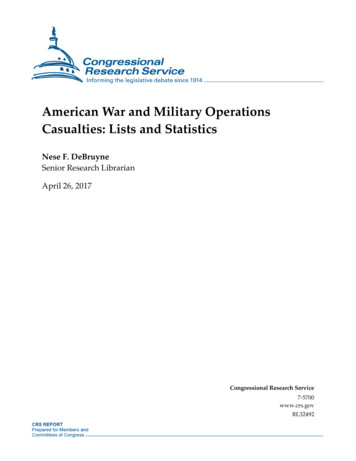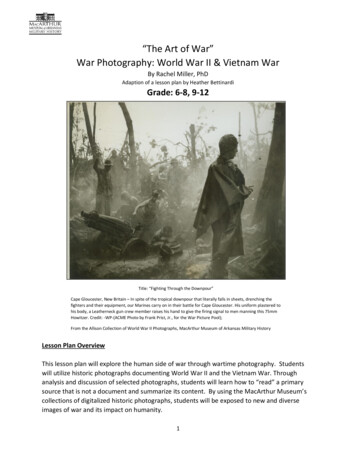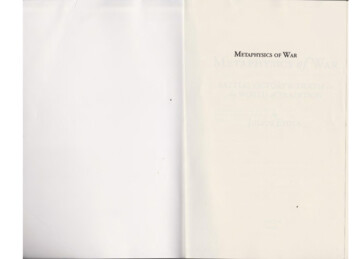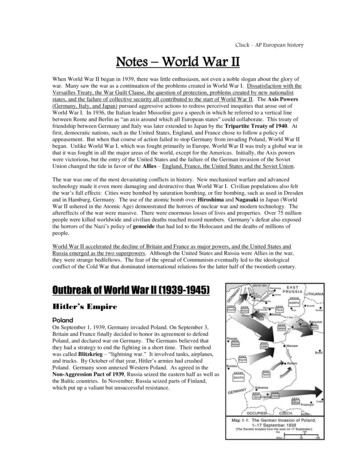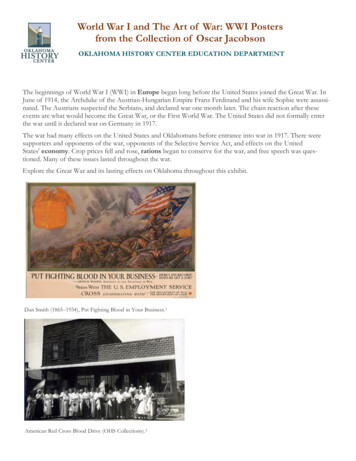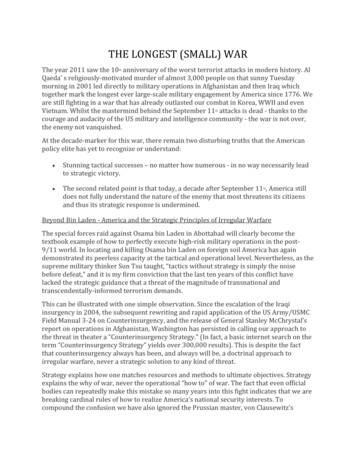
Transcription
THE LONGEST (SMALL) WARThe year 2011 saw the 10th anniversary of the worst terrorist attacks in modern history. AlQaeda’ s religiously-motivated murder of almost 3,000 people on that sunny Tuesdaymorning in 2001 led directly to military operations in Afghanistan and then Iraq whichtogether mark the longest ever large-scale military engagement by America since 1776. Weare still fighting in a war that has already outlasted our combat in Korea, WWII and evenVietnam. Whilst the mastermind behind the September 11th attacks is dead - thanks to thecourage and audacity of the US military and intelligence community - the war is not over,the enemy not vanquished.At the decade-marker for this war, there remain two disturbing truths that the Americanpolicy elite has yet to recognize or understand: Stunning tactical successes – no matter how numerous - in no way necessarily leadto strategic victory. The second related point is that today, a decade after September 11th, America stilldoes not fully understand the nature of the enemy that most threatens its citizensand thus its strategic response is undermined.Beyond Bin Laden - America and the Strategic Principles of Irregular WarfareThe special forces raid against Osama bin Laden in Abottabad will clearly become thetextbook example of how to perfectly execute high-risk military operations in the post9/11 world. In locating and killing Osama bin Laden on foreign soil America has againdemonstrated its peerless capacity at the tactical and operational level. Nevertheless, as thesupreme military thinker Sun Tsu taught, “tactics without strategy is simply the noisebefore defeat,” and it is my firm conviction that the last ten years of this conflict havelacked the strategic guidance that a threat of the magnitude of transnational andtranscendentally-informed terrorism demands.This can be illustrated with one simple observation. Since the escalation of the Iraqiinsurgency in 2004, the subsequent rewriting and rapid application of the US Army/USMCField Manual 3-24 on Counterinsurgency, and the release of General Stanley McChrystal’sreport on operations in Afghanistan, Washington has persisted in calling our approach tothe threat in theater a “Counterinsurgency Strategy.” (In fact, a basic internet search on theterm “Counterinsurgency Strategy” yields over 300,000 results). This is despite the factthat counterinsurgency always has been, and always will be, a doctrinal approach toirregular warfare, never a strategic solution to any kind of threat.Strategy explains how one matches resources and methods to ultimate objectives. Strategyexplains the why of war, never the operational “how to” of war. The fact that even officialbodies can repeatedly make this mistake so many years into this fight indicates that we arebreaking cardinal rules of how to realize America’s national security interests. Tocompound the confusion we have also ignored the Prussian master, von Clausewitz’s
warning that the most important responsibility of the commander, or leader, is to firstunderstand the nature of the conflict he is about to embark upon. Likewise, we haveinstitutionally failed to meet our duty to become well-informed on the Threat Doctrine ofour enemy. And without a clear understanding of the Enemy Threat Doctrine, victory islikely impossible.The reasons for our paucity in this area are many. Most of these stem from two serious andinterconnected obstacles of strategic magnitude. The first is a misguided belief that thereligious character of the enemy’s ideology should not be discussed, and that we need notaddress it, but should instead use the phrase “Violent Extremism” to describe our foe andthus avoid any unnecessary unpleasantness. The second is that even if we coulddemonstrate clear-headedness on the issue and recognize the religious ideology of al Qaedaand its associate movements for what it is: a form of hybrid totalitarianism, we stilldrastically lack the institutional ability to analyze and comprehend the worldview of theenemy and therefore its strategic mindset and ultimate objectives.Here it is enlightening to look to the past to understand just how great a challenge is posedby the need for our national security establishment to understand its new enemy. It is nowwell recognized that it was only in 1946, with the authoring of George Kennan’s classified‘Long Telegram’ (later republished pseudonymously as The Sources of Soviet Conduct) thatAmerica began to understand the nature of the Soviet Union, why it acted the way it did,how the Kremlin thought, and why the USSR was an existential threat to America.[1]Consider now the fact that this document was written three decades after the RussianRevolution, and that despite all the scholarship and analysis available in the United States,it took more than a generation to penetrate the mind of the enemy and come to a pointwhere a counter-strategy could be formulated in the shape of Paul Nitze’s NSC-68.[2] Nowadd to this the fact that today our enemy is not a European secular nation-state, as was theUSSR, but a non-European, religiously-informed non-state terrorist group, and we see themagnitude of the challenge. Whilst initiatives such as Fort Leavenworth’s Human TerrainSystem (HTS) and the teams they provide to theater commanders are well meant efforts inthe right direction of trying to understand the context of the enemy, they still miss the markon more than one level.To begin with, it is very difficult, if not impossible, to provide the contextual knowledge weneed to understand and defeat our enemy if we rely solely upon anthropologists and socialscientists, as the HTS does. Today our multi-disciplinary analysis of the enemy and hisdoctrine just as much requires – if not more so – the expertise of the regional historian andthe theologian, the specialist who knows when and how Sunni Islam split from Shia Islamand what the difference is between the Meccan and Medinan verses of the Khoran. Weshould ask ourselves honestly, how many national security practitioners know the answersto these questions, or at least have somewhere to turn to within government to providethem such essential expertise.Secondly, we must, after seven years, take the counsel of the 9/11 congressionalcommission seriously in recognizing that the threat environment itself has radicallychanged beyond the capacity of our legacy national security structures to deal with it.
In the case of how two of the 9/11 hijackers (Nawaf al-Hamzi and Khalid al-Midhar) wereflagged as threats and then still permitted to enter the United States legally, we see proof ofhow our national security structures do not live up to the threat our new enemiesrepresent. This problem is not unique to the United States, but a product of what theacademic world calls the Westphalian system of nation-states and how we are structuredto protect ourselves.For the 350 years since the Treaty of Westphalia that ended the religious wars of Europe,Western nations developed and perfected national security architectures that werepredicated on an institutional division of labor and discrete categorization of threats.Internally we had to maintain constitutionality and law and order. Externally we had todeal with the threat of aggression by another state. As a result all our countries divided thenational security task-set into separate conceptual and functional baskets: internal versusexternal, military versus non-military. And this system worked very well for three and halfcenturies during which time states fought other nation-states, the age of so-called‘conventional warfare.’ However, as Philip Bobbitt has so masterfully described in his bookThe Shield of Achilles, that age is behind us. Al Qaeda, Al Shabaab, or even the MuslimBrotherhood cannot be forced into analytic boxes which are military or non-military, orinto internal or external threat categories.[3] We must recognize the hard truth that thethreat environment is no longer primarily defined by the state-actor.Take, for example, the case of the most successful al Qaeda attack on US soil since 9/11, theFort Hood massacre. A serving Major in the US Army decided that his loyalty lay with hisMuslim co-religionists and not his nation, or his branch of service. He was recruited,encouraged and finally blessed in his actions by the late Anwar al-Awlaki, a US citizen whowas a Muslim cleric then hiding out in Yemen. When MAJ Hasan was about to be deployedinto theater in the service of our country, he instead chose the path of Holy War against theinfidel and slew 13 and wounded 31 of his fellow servicemen and their family membersand colleagues on the largest US Army base in the United States.How Westphalian was this deadly attack by al Qaeda? What does it have to do withconventional warfare? Was this threat external or internal in nature? Was it a militaryattack or a non-military one? As you see, the conceptual frameworks and capabilities thatserved us so well through the last century fail us today in the 21st. As a result we mustdevelop new methodologies to analyze the threats to our nation and new ways to bridgethe conventional gaps between government and agency departments and their respectivemindsets, gaps which are so deftly exploited by groups such al Qaeda.[4] We mustrecognize that the master of military strategy, von Clausewitz, wrote his mesiterwerk in thecontext of station state war. His trinity of government, people and military and the relatedcharacteristics or reason, passion and skill do not obtain in the realm of irregular warfareas they do in conventional war (see illustration). Today the enemy is more flexible and notdriven by rational conceptualizations of raison d’etat. One draft redrawing of theClausewitzian Trinity is as follows: [5]
Figure One: Clausewitz versus Irregular WarfareThe paradox of al Qaeda is that whilst we have in the last 10 years been incrediblysuccessful in militarily degrading its operational capacity to directly do us harm, al Qaedahas become even more powerful in the domain of ideological warfare and other indirectforms of attack. Whilst bin Laden may be dead, the narrative of religiously-motivated globalrevolution that he embodied is very much alive and growing in popularity.[6] Whilst wehave crippled al Qaeda’s capacity to execute mass casualty attacks with its own assets onthe mainland of the United States, we see that its message has and holds traction withindividuals prepared to take the fight to us individually, be it Major Hasan, Faisal Shahzad,the Times Square attacker, or Umar Farouk Abdulmutallab, the Christmas-Day bomber.Counterterrorism: Beyond the KineticAlthough we have proven our capacity in the last 10 years to kinetically engage our enemyat the operational and tactical level with unsurpassed effectiveness, we have not evenbegun to take the war to al Qaeda at the strategic-level of counter-ideology. To paraphraseDr. James Kiras of the Air University, we have denied al Qaeda the capability to conductcomplex devastating attacks on the scale of 9/11, but we now need to transition away fromconcentrating on dismantling and disrupting al Qaeda’s network, to undermining its corestrategy of ideological attack. We need to employ much more the indirect approach madefamous by our community of Special Forces operators of working “by, with and through”local allies and move beyond attacking the enemy directly at the operational and tacticallevel to attacking it indirectly at the strategic level.We need to bankrupt transnational Jihadist terrorism at it most powerful point: itsnarrative of global religious war. For the majority of the last ten years the narrative of the
conflict has been controlled by our enemy. Just as in the Cold War, the United States musttake active measures to arrive at a position where it shapes the agenda and the story of theconflict, where we force our enemy onto the back foot to such an extent that Jihadismeventually loses all credibility and implodes as an ideology. For this to happen we must rethink from the ground up the way in which strategic communications and informationoperations are run across the US government. Additionally, Congress itself will have workto do to remove out-dated limitations on our national ability to fight the war of ideas, suchas the Smith-Mundt Act, which were born of a by-gone age before the world of moderncommunications and especially the internet.Our ability to fight al Qaeda and similar transnational terrorist actors will depend upon ourcapacity to communicate to our own citizens and to the world what it is we are fighting forand what it is that the ideology of Jihad threatens in terms of the universal values we holdso dear. To quote Sun Tsu again, in war it is not enough to know the enemy in order to win.One must first know oneself. During the Cold War this happened naturally. Given thenature of the Soviet Union and the nuclear threat it clearly posed to the West, from the firstsuccessful Soviet atom-bomb test to the collapse of the USSR in 1991, every day for fourdecades Americans knew what was at stake and why Communism could not be allowed tospread its totalitarian grip beyond the Iron Curtain.However, with the end of the Cold War and the decade of peace dividends that was the1990s, America and the West understandably lost clarity with regard to what it was aboutits way of life that was precious and worth fighting since the specter of WWIII had beenvanquished and the (Cold) war had been won.The shock of the September 11th attacks did not, however, automatically return us to a pointof clarity. The reasons for this flow from several of the observations made above, but alsofrom the fact that now our enemy is a religiously-colored one unlike the secular foe wefaced during the Cold War.Due in part to a misinterpretation of what the Founding Fathers actually meant by“separation of church and state,” today we have hobbled our capacity to understand andcounter this enemy at the strategic level. Based upon my experience with militaryoperators and also US law enforcement officers fighting terrorism at home, many in seniormanagement positions in government have misconstrued the matter to such an extent thatreligion has become a taboo issue within national threat analysis. This is despite that factthat all those who have brought death to our shores as al Qaeda operatives have done sonot out of purely political conviction but clearly as a result of the fact that they feeltranscendentally justified, that they see their violent deeds as sanctioned by God. If we wishto combat the ideology that drives these murderers, we ignore the role of religion at ourperil.The official decision in recent years to use the term “Violent Extremism” to describe thethreat is misleading and deleterious to our ability to understand the enemy and defeat it.America is not at war with all forms of violent extremism. The attacks of September 11thwere the work not of a group of terrorists motivated by a generic form of extremism. Weare not at war with communists, fascists or nationalists but religiously inspired mass-
murderers who consistently cite the Khoran to justify their actions. Denying this factsimply out of a misguided sensitivity will delay our ability to understand the nature of thisconflict and to delegitimize our foe. By analogy, imagine if in the fight against the Ku KluxKlan federal law enforcement had been forbidden from describing the group they weretrying to neutralize as white supremacists or racists, or if during WWII, for politicalreasons, we forbad our forces from understanding the enemy as a Nazi regime fueled andguided by a fascist ideology of racial hatred, but forced them to call them “violentextremists” instead. We did not do it then and we must not do it now. The safety ofAmerica’s citizens and our chances of eventual victory depend upon our being able to callthe enemy by its proper name: Global Jihadism.[7]To conclude, the last ten years since September 11th 2001 can be summarized as a vastcollection of tactical and operational successes but a vacuum in terms of strategicunderstanding and strategic response. To paraphrase a former US Marine who knows theenemy very well, “we have failed to understand the enemy at any more than an operationallevel and have instead, by default, addressed the enemy solely on the operational plane ofengagement.” Operationally we have become most proficient at responding to the localizedthreats caused by al Qaeda, but those localized threats are simply tactical manifestations ofwhat is happening at the strategic level and driven by the ideology of Global Jihad. As aresult, by not responding to what al Qaeda has become at the strategic level, we continue toattempt to engage it on the wrong battlefield.The tenth anniversary of the attacks in Washington, in New York and in Pennsylvania,afford those in the US government who have sworn to uphold and defend the nationalinterests of this greatest of nations a clear opportunity to recognize what we haveaccomplished and what needs to be reassessed. All involved must begin anew to recommitthemselves to attacking this deadliest of enemies at the level which is deserves to be – andmust be – which is, of course, the strategic.Osama bin Laden may be dead, but his ideology of global supremacy through religious waris far more vibrant and sympathetic to audiences around the world than it was on the daybefore the attacks ten years ago. We need to guarantee the conditions by which theexecutive branch is able finally to produce a comprehensive understanding of the enemythreat doctrine that is Global Jihadism, a document akin to Kennan’s foundational analysisthat eventually led to the Truman Doctrine and its exquisite operationalization in PaulNitze’s plan for containment, NSC-68.Ten years into this war, a strategic re-evaluation is justified. Four practical principlesshould guide such a reevaluation:[8]I.The United States must suppress the sphere of mobility of al Qaeda and itsAssociated Movements (AQAM). This war with not end in a neat ceasefire and peacetreaty. It must consist of a constant pressure against both the will and the capabilityof Global Jihadists to do us harm.II.The American intelligence and national security communities must invest fargreater effort into understanding the Historic, Economic, Social and Political factors
that AQAM uses to mobilize its followers and operators. This is NOT a cause andeffect relationship, but a dynamic whereby elite ideologies exploit objectivecondition through a subject mobilizing religious ideology.III.This war is no longer simply about hijacked planes, IEDs or gun-men. Ten yearsafter 9/11 it is perhaps more non-kinetic than it is physical. America mustrediscovered and deploy the tools it used so effectively in past ideological wars tobuild a powerful and globally applicable counter-narrative. This narrative mustundermine the legitimacy and attractiveness of the enemy, as well as deter potentialallies and recruits. America must drive the global agenda of justice and liberty, as itdid during WWII and the Cold War.[9]IV.The American national security establishment must purge itself of well-intentionedbut neutering concepts of political correctness and cultural sensitivity concernedwho the enemy is and what it intends. AQAM uses religion not only to win adherentsbut also justify mass-murder. We must tackle this reality head-on. The religiousnature of our enemy’s ideology cannot obstruct us from defining and realizing ournational interests.Only if we have an overarching strategic response will America be able to defeat al Qaedaand its associates before the next significant anniversary of 9/11.The views herein expressed do not necessarily represent those of the US Department ofDefense or any other government agency.[1] The declassified text of Kennan’s original cable can be found athttp://www.ntanet.net/KENNAN.html. The pseudonymous article he later wrote for abroader audience in Foreign Affairs is athttp://www.historyguide.org/europe/kennan.html .[2] The declassified NSC-68 which operationalized George Kennan’s enemy threat doctrineanalysis of the USSR is available at: cuments/2004/December%202004/1204keeperfull.pdf (accessed 15th June 2011).[3] Philip Bobbitt: The Shield of Achilles – War, Peace and the Course of History, (New York,N.Y.: Random House), 2002. In “The Age of Irregular Warfare – So What?,” in Joint ForcesQuarterly, Issue 58, 3rd Quarter, 2010, (p 32-38) I take the discussion further and discussjust how different this post-Westphalian threat environment is and how we need toreappraise key Clausewitzian aspects of the analysis of war.
[4] For a discussion of how to institutionally and conceptually bridge these gaps and so beable to defeat the new types of threat we face see the concept “Super-Purple” described inmy chapter “International Cooperation as a Tool in Counterterrorism: Super-Purple as aWeapon to Defeat the Nonrational Terrorist,” in Toward a Grand Strategy AgainstTerrorism, Christopher C. Harmon, Andrew N. Pratt and Sebastian L. v. Gorka (eds.), (NewYork, N.Y.: McGraw Hill) 2011, 71-83.[5] See S. L. v. Gorka “The Age of Irregular Warfare: So What?, op. cit.[6] For the rise of Jihadi ideology and what should be done in response, see Sebastian L. v.Gorka: “The Surge that Could Defeat Al Qaeda,” ForeignPolicy.Com, 10 AUG 2009, /the one surge that could defeat alqaeda (accessed 15th June 2011).[7] For the best work on understanding the enemy we now face see Patrick Sookhdeo’sGlobal Jihad: The Future in the Face of militant Islam, Isaac Publishing, McLean, VA, 2007,and the analytic work of Stephen Ulph, including: Towards a Curriculum for TeachingJihadist Ideology, The Jamestown Foundation, available athttp://www.jamestown.org/single/?no cache 1&tx ttnews%5Btt news%5D 36999. Foran overview of the key thinkers and strategists of Global Jihadi ideology see Sebastian L. v.Gorka: Jihadist ideology: The Core Texts, lecture to the Westminster institute. Audio andtranscript available at dist-ideologythe-core-texts-3/#more-385 (both accessed 15 June 2011).[8] For a lengthier discussion of these principles, see the forthcoming monograph by Gorka,Sloan and Ishimoto from the Joint Special Operations University, US Special OperationsCommand.[9] For a detailed analyis of al Qaeda’s strategoic communications and how we shouldbuild a counter see S. Gorka and D. Kilcullen: Who’s Winning the Battle for Narrative? Within “Influence Warfare,” ed. James J. F. Forest, (Praeger Security International, Westport, CT),2009
Beyond Bin Laden - America and the Strategic Principles of Irregular Warfare The special forces raid against Osama bin Laden in Abottabad will clearly become the textbook example of how to perfectly execute high-risk military operations in the post-9/11 world. In locating and killing Osama bin Laden on foreign soil America has again



